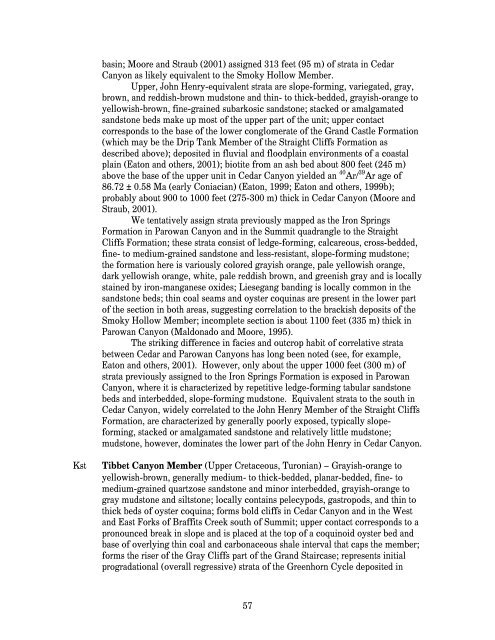Interim Geologic Map of the West Part of - Utah Geological Survey
Interim Geologic Map of the West Part of - Utah Geological Survey
Interim Geologic Map of the West Part of - Utah Geological Survey
You also want an ePaper? Increase the reach of your titles
YUMPU automatically turns print PDFs into web optimized ePapers that Google loves.
asin; Moore and Straub (2001) assigned 313 feet (95 m) <strong>of</strong> strata in CedarCanyon as likely equivalent to <strong>the</strong> Smoky Hollow Member.Upper, John Henry-equivalent strata are slope-forming, variegated, gray,brown, and reddish-brown mudstone and thin- to thick-bedded, grayish-orange toyellowish-brown, fine-grained subarkosic sandstone; stacked or amalgamatedsandstone beds make up most <strong>of</strong> <strong>the</strong> upper part <strong>of</strong> <strong>the</strong> unit; upper contactcorresponds to <strong>the</strong> base <strong>of</strong> <strong>the</strong> lower conglomerate <strong>of</strong> <strong>the</strong> Grand Castle Formation(which may be <strong>the</strong> Drip Tank Member <strong>of</strong> <strong>the</strong> Straight Cliffs Formation asdescribed above); deposited in fluvial and floodplain environments <strong>of</strong> a coastalplain (Eaton and o<strong>the</strong>rs, 2001); biotite from an ash bed about 800 feet (245 m)above <strong>the</strong> base <strong>of</strong> <strong>the</strong> upper unit in Cedar Canyon yielded an 40 Ar/ 39 Ar age <strong>of</strong>86.72 ± 0.58 Ma (early Coniacian) (Eaton, 1999; Eaton and o<strong>the</strong>rs, 1999b);probably about 900 to 1000 feet (275-300 m) thick in Cedar Canyon (Moore andStraub, 2001).We tentatively assign strata previously mapped as <strong>the</strong> Iron SpringsFormation in Parowan Canyon and in <strong>the</strong> Summit quadrangle to <strong>the</strong> StraightCliffs Formation; <strong>the</strong>se strata consist <strong>of</strong> ledge-forming, calcareous, cross-bedded,fine- to medium-grained sandstone and less-resistant, slope-forming mudstone;<strong>the</strong> formation here is variously colored grayish orange, pale yellowish orange,dark yellowish orange, white, pale reddish brown, and greenish gray and is locallystained by iron-manganese oxides; Liesegang banding is locally common in <strong>the</strong>sandstone beds; thin coal seams and oyster coquinas are present in <strong>the</strong> lower part<strong>of</strong> <strong>the</strong> section in both areas, suggesting correlation to <strong>the</strong> brackish deposits <strong>of</strong> <strong>the</strong>Smoky Hollow Member; incomplete section is about 1100 feet (335 m) thick inParowan Canyon (Maldonado and Moore, 1995).The striking difference in facies and outcrop habit <strong>of</strong> correlative stratabetween Cedar and Parowan Canyons has long been noted (see, for example,Eaton and o<strong>the</strong>rs, 2001). However, only about <strong>the</strong> upper 1000 feet (300 m) <strong>of</strong>strata previously assigned to <strong>the</strong> Iron Springs Formation is exposed in ParowanCanyon, where it is characterized by repetitive ledge-forming tabular sandstonebeds and interbedded, slope-forming mudstone. Equivalent strata to <strong>the</strong> south inCedar Canyon, widely correlated to <strong>the</strong> John Henry Member <strong>of</strong> <strong>the</strong> Straight CliffsFormation, are characterized by generally poorly exposed, typically slopeforming,stacked or amalgamated sandstone and relatively little mudstone;mudstone, however, dominates <strong>the</strong> lower part <strong>of</strong> <strong>the</strong> John Henry in Cedar Canyon.KstTibbet Canyon Member (Upper Cretaceous, Turonian) − Grayish-orange toyellowish-brown, generally medium- to thick-bedded, planar-bedded, fine- tomedium-grained quartzose sandstone and minor interbedded, grayish-orange togray mudstone and siltstone; locally contains pelecypods, gastropods, and thin tothick beds <strong>of</strong> oyster coquina; forms bold cliffs in Cedar Canyon and in <strong>the</strong> <strong>West</strong>and East Forks <strong>of</strong> Braffits Creek south <strong>of</strong> Summit; upper contact corresponds to apronounced break in slope and is placed at <strong>the</strong> top <strong>of</strong> a coquinoid oyster bed andbase <strong>of</strong> overlying thin coal and carbonaceous shale interval that caps <strong>the</strong> member;forms <strong>the</strong> riser <strong>of</strong> <strong>the</strong> Gray Cliffs part <strong>of</strong> <strong>the</strong> Grand Staircase; represents initialprogradational (overall regressive) strata <strong>of</strong> <strong>the</strong> Greenhorn Cycle deposited in57
















